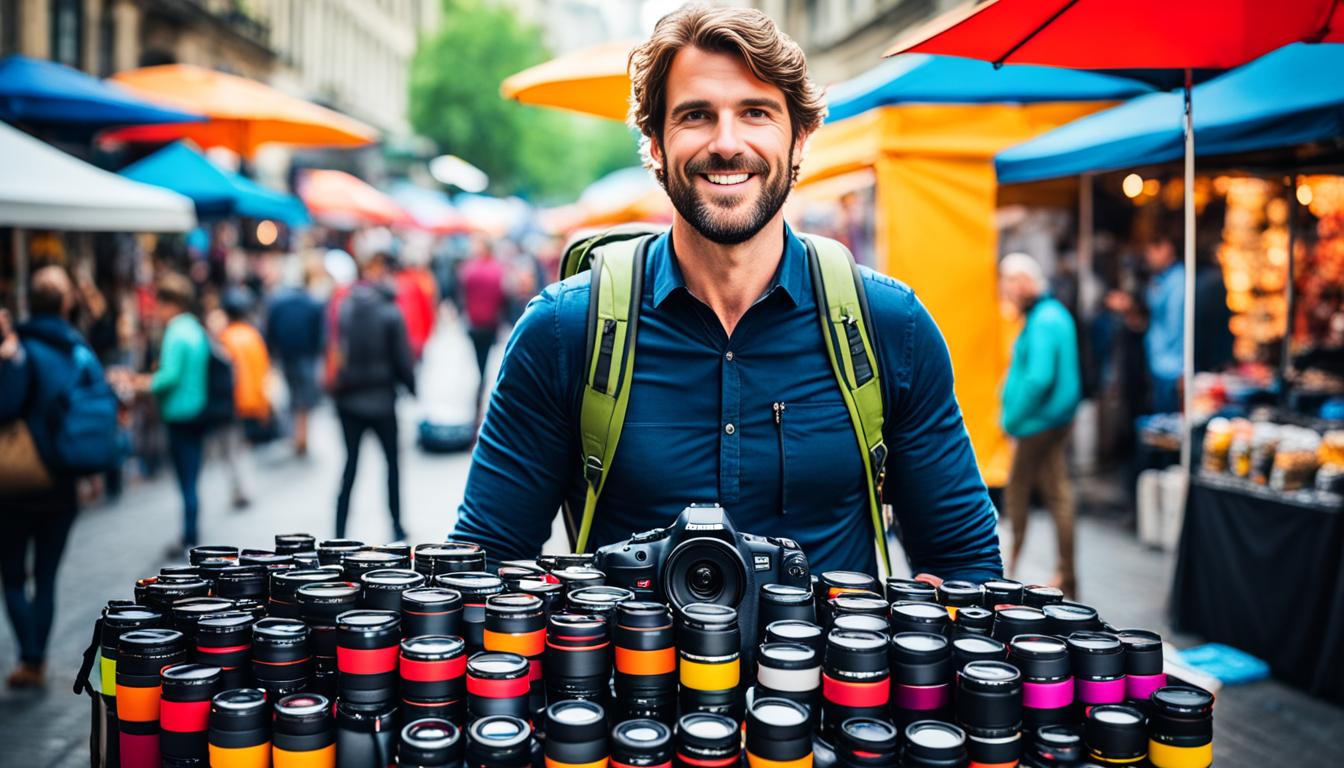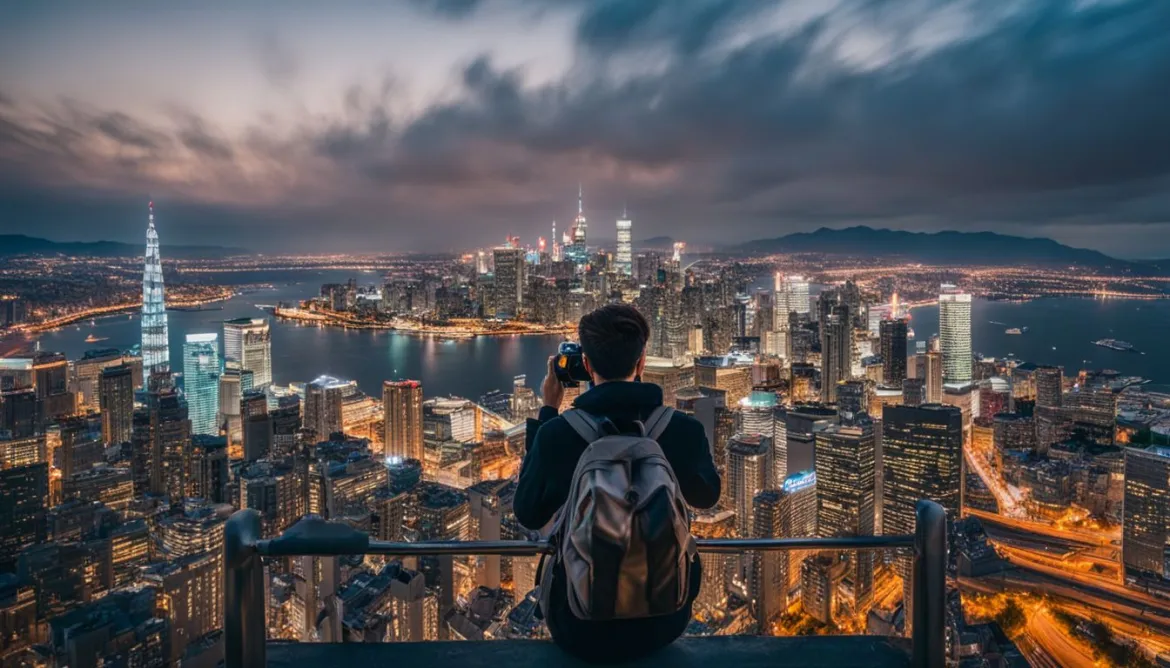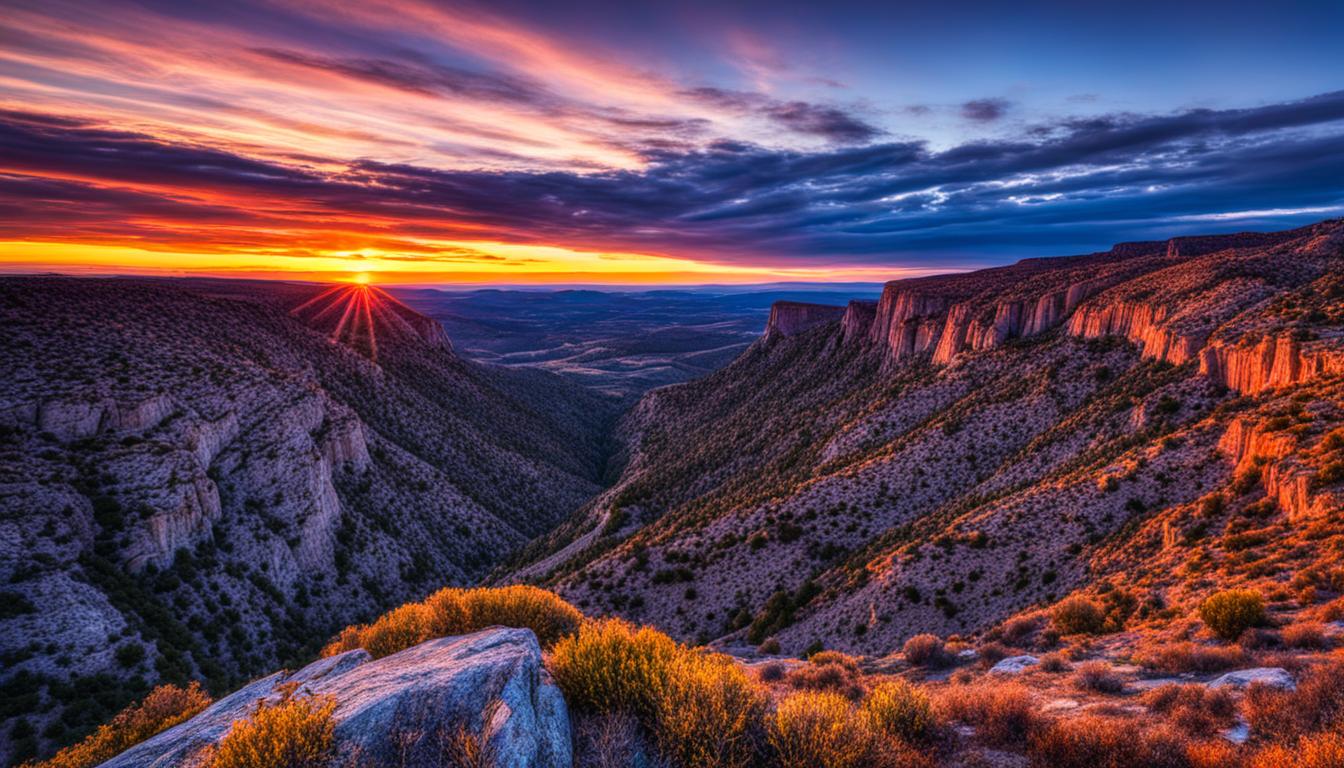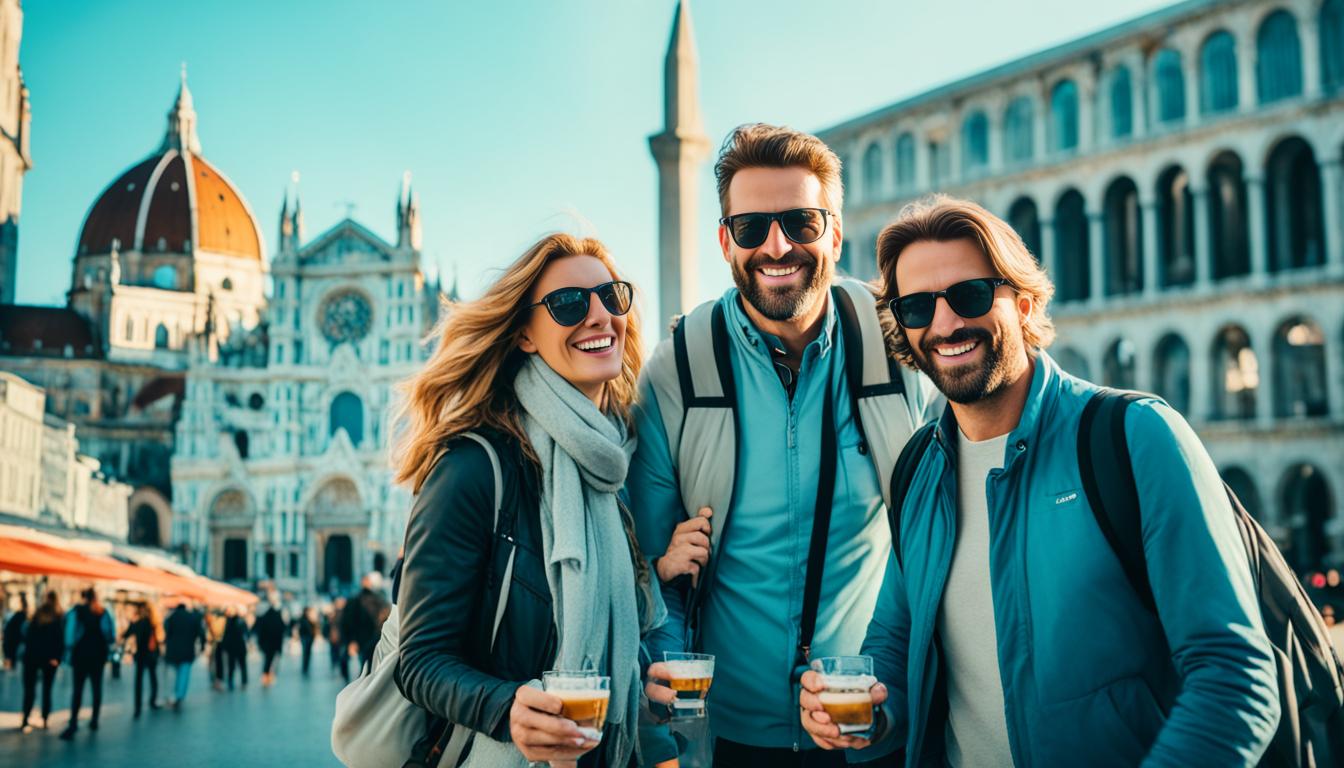Taking stunning solo travel photos can be a challenge, but with the right tips and techniques, you can capture amazing shots that showcase your solo adventures. In this article, we will share a comprehensive guide on solo travel photography, covering everything from equipment essentials to composition tips and posing suggestions. Whether you are a beginner or an experienced photographer, these tips will help you take your solo travel photography to the next level.
Key Takeaways:
- Equip yourself with essential camera gear for solo travel photography.
- Master composition techniques such as the rule of thirds, leading lines, and framing.
- Experiment with different poses and self-timer techniques to capture natural and engaging shots.
- Utilize lighting conditions to enhance the mood and atmosphere of your photos.
- Edit your solo travel photos to enhance colors and create a consistent style.
Equipment Essentials for Solo Travel Photography
Having the right equipment is crucial for capturing great solo travel photos. Whether you’re a beginner or a seasoned photographer, having the right gear can make a big difference in the quality and impact of your shots. In this section, we will discuss the essential camera equipment you need for solo travel photography, including cameras, lenses, and tripods. We will also provide recommendations for the best cameras and lenses for solo travel photography, as well as tips for choosing the right tripod to suit your needs.
Cameras
When it comes to choosing a camera for solo travel photography, there are a few key factors to consider. Firstly, think about your preferred shooting style and the type of shots you want to capture. If you’re looking for something compact and lightweight, a mirrorless camera or a high-end compact camera may be a good option. These cameras offer excellent image quality and versatility while being easy to carry during your travels. Some popular options include the Sony Alpha a6000 and the Canon PowerShot G7 X Mark III.
If you prefer a more traditional DSLR camera with interchangeable lenses, there are plenty of options available. The Canon EOS Rebel T7i and the Nikon D5600 are great entry-level DSLRs that offer a good balance between performance and price. For more advanced photographers, the Canon EOS 5D Mark IV and the Nikon D850 are highly regarded for their professional-level features and image quality.
Lenses
Choosing the right lenses for your solo travel photography is just as important as selecting the camera itself. The lens you choose will determine the perspective, focal length, and overall look of your photos. For general travel photography, a versatile zoom lens, such as a 24-70mm or an 18-135mm lens, can be a great option. These lenses cover a wide range of focal lengths, allowing you to capture everything from wide-angle landscapes to close-up details.
If you’re into landscape photography or want to capture more wide-angle shots, consider investing in a wide-angle lens, such as a 16-35mm or a 10-20mm lens. These lenses are perfect for capturing expansive landscapes and architectural details. For capturing distant subjects, a telephoto lens, such as a 70-200mm or a 100-400mm lens, can be useful for bringing the action closer and isolating subjects.
Tripods
A sturdy tripod is an essential piece of gear for solo travel photography. It allows you to stabilize your camera and capture sharp photos, especially in low-light situations or when using slow shutter speeds. When choosing a tripod, consider the weight, size, and stability. Look for lightweight, compact tripods that are easy to carry and durable enough to withstand different terrains.
There are various types of tripods available, including full-size tripods, travel tripods, and mini tripods. Full-size tripods provide maximum stability but can be bulky and heavy to carry. Travel tripods are designed to be more lightweight and compact, making them ideal for solo travelers. Mini tripods, such as the Joby GorillaPod, are flexible and can be easily attached to different surfaces, offering versatility in a compact package.
| Camera | Recommendation |
|---|---|
| Sony Alpha a6000 | Compact mirrorless camera with excellent image quality |
| Canon PowerShot G7 X Mark III | High-end compact camera with versatile features |
| Canon EOS Rebel T7i | Entry-level DSLR with great performance |
| Nikon D5600 | Beginner-friendly DSLR with impressive image quality |
| Canon EOS 5D Mark IV | Professional-level DSLR with exceptional features |
| Nikon D850 | High-resolution DSLR for advanced photographers |
Composition Tips for Solo Travel Photography
When it comes to solo travel photography, composition is an essential element that can greatly enhance the impact of your photographs. By using various composition techniques, you can create visually appealing and captivating images that tell a story of your solo adventures.
One popular composition technique to consider is the rule of thirds. This technique involves dividing your frame into nine equal parts by placing two horizontal and two vertical lines. The key elements of your photo should then be positioned along these lines or at the intersections, resulting in a well-balanced and visually pleasing composition.

Another powerful composition technique is the use of leading lines. These are natural or man-made lines that guide the viewer’s eye towards the main subject of your photo. Examples of leading lines can include roads, fences, or even patterns in the environment. By strategically incorporating leading lines into your composition, you can create a sense of depth and draw attention to the focal point of your image.
In addition to the rule of thirds and leading lines, framing is another composition technique that can enhance your solo travel photos. Framing involves using objects or elements within the scene to create a frame around your main subject. This can add a sense of context and depth to your photographs, as well as create a more focused and engaging composition.
By applying these composition techniques, you can elevate your solo travel photography and create images that truly capture the essence of your solo adventures. Experiment with different angles, perspectives, and compositions to find what works best for each unique location and subject.
Example of Rule of Thirds in Solo Travel Photography:
Imagine you’re standing on the edge of a breathtaking cliff overlooking a vast mountain range. To apply the rule of thirds, you would position the horizon line along the bottom third or top third of the frame, depending on whether you want to emphasize the sky or the landscape. The main focal point, such as a lone tree or a hiker, can then be placed along one of the vertical lines, creating a visually balanced image that draws the viewer’s eye into the scene.
Example of Leading Lines in Solo Travel Photography:
While exploring a bustling city, you may come across a street lined with colorful buildings. By positioning yourself at the end of the street and using the converging lines of the buildings, you can create a composition that leads the viewer’s gaze from the foreground to the distant skyline, adding depth and visual interest to your solo travel photograph.
Example of Framing in Solo Travel Photography:
When visiting an ancient temple, you may find a beautifully ornate doorway or archway. By framing your main subject, such as a statue or a temple interior, within the doorway, you create a natural frame that draws attention to the subject and adds a sense of context and intrigue to your solo travel photo.
Poses and Self-Timer Techniques for Solo Travel Photography
When traveling solo, capturing memorable photographs of yourself can be a rewarding experience. However, finding the right poses and techniques can be a challenge. In this section, we will explore various posing ideas and self-timer techniques that will help elevate your solo travel photography to the next level.
Posing Ideas for Solo Travel Photography
Posing naturally can make a significant difference in the outcome of your solo travel photos. Experiment with different poses to showcase the unique aspects of your journey. Here are a few posing ideas to get you started:
- Engaged in the surroundings: Lean against a rustic wall or sit on a picturesque bench, allowing the background to complement your presence.
- Moving with confidence: Walk confidently towards the camera while maintaining a relaxed posture. This conveys a sense of adventure and exploration.
- Showing scale: Incorporate elements in the foreground, such as holding small objects or standing in front of large landmarks, to highlight the vastness of your surroundings.
Remember, the key to capturing captivating poses is authenticity. Be yourself and let your personality shine through in your solo travel photos.
Self-Timer Techniques for Solo Travel Photography
Using the self-timer feature on your camera or smartphone can help you achieve stunning solo shots without the need for a photographer. Here are a few self-timer techniques to enhance your solo travel photography:
- Steady support: Find a stable surface to place your camera or use a tripod for steady shots. This ensures your images are sharp and focused.
- Time for the perfect moment: Set the self-timer delay to allow yourself ample time to get into position and compose your shot.
- Capturing candid moments: Set your camera to continuous shooting mode, and let the self-timer capture a series of photos. This technique can result in candid shots that truly capture the essence of your solo adventures.
Experiment with different angles, perspectives, and compositions to add variety to your self-timer shots. Don’t be afraid to try multiple takes to get the perfect photo.
Using Props in Solo Travel Photography
Props can add a creative and personalized touch to your solo travel photos. They can enhance the storytelling aspect and make your images stand out. Consider incorporating props that are relevant to your travel experience or reflect your personality. Some ideas for using props in solo travel photography include:
- Maps or guidebooks: Hold a map or guidebook open to a specific location, highlighting the destination you are exploring.
- Travel accessories: Showcasing your favorite travel accessories, such as a camera, hat, or backpack, can add visual interest to your photos.
- Local products: Incorporate local foods, souvenirs, or cultural items to create a sense of place and authenticity in your solo travel photos.
Be resourceful and make use of the objects around you. Props can add depth and context to your images, making them more engaging for your viewers.
Capturing Candid Shots in Solo Travel Photography
Candid shots can offer a glimpse into the genuine moments of your solo travel adventures. They capture the raw emotions and authenticity of your experiences. Here are a few tips for capturing candid shots:
- Blend in: Be inconspicuous and observe the surroundings. This allows you to capture authentic moments without interrupting the scene.
- Use a telephoto lens: A telephoto lens allows you to capture candid shots from a distance, giving your subjects the freedom to act naturally.
- Timing is key: Anticipate interesting moments and be ready to capture them. Patience is crucial when waiting for the perfect candid shot.
Candid shots can evoke powerful emotions and tell captivating stories. Embrace the unpredictability of these moments and embrace the beauty of spontaneity in your solo travel photography.
Summary
In this section, we explored various posing ideas, self-timer techniques, the use of props, and how to capture candid shots in solo travel photography. Remember, the key to capturing stunning solo travel photos is to be authentic and let your personality shine through. Experiment with different poses and techniques to create captivating images that truly showcase your solo adventures.
Lighting Tips for Solo Travel Photography
When it comes to solo travel photography, lighting is a game-changer. The right lighting can enhance the mood, create depth, and bring your photos to life. In this section, we will provide you with valuable tips on how to make the most of lighting in your solo travel photography.
Finding the Best Lighting Conditions
Whether you’re shooting outdoors or indoors, natural light can be your best friend. It’s readily available, versatile, and flattering. One of the best times to capture stunning photos is during the golden hour, which is the period shortly after sunrise or before sunset. The soft, warm light during this time creates a magical and ethereal ambiance. Take advantage of the golden hour by planning your shoots accordingly.
During the day, keep an eye out for diffused light, which occurs when the sun is partially or completely blocked by clouds. Diffused light eliminates harsh shadows and creates a soft, even illumination that works well for various photography genres.
When shooting indoors, try to position yourself near windows to utilize the natural light streaming in. Avoid relying solely on artificial lighting, as it can often create unflattering shadows or an unnatural look. If you must use artificial lighting, consider investing in a portable LED light panel that can mimic the softness of natural light.
Using Natural Light in Solo Travel Photography
Natural light can be incredibly versatile and can be manipulated to achieve different effects in your solo travel photography. Here are a few techniques to consider:
- Backlighting: Position yourself or your subject in front of a light source, such as the sun, to create a beautiful halo effect. This technique works particularly well for capturing silhouettes or emphasizing the shape and form of your subject.
- Side-lighting: Position yourself or your subject so that the light is coming from the side. This technique creates depth, enhances texture, and adds drama to your photos.
- Front-lighting: Place yourself or your subject facing the light source. This technique results in evenly lit subjects and brings out the details and colors in your photos.
Artificial Lighting for Solo Travel Photography
While natural light is preferred in most cases, there are times when artificial lighting can come in handy. Here are a few scenarios where artificial lighting can be beneficial:
- Low-light situations: When shooting in low-light environments, such as during nighttime or in dimly lit interiors, you may need to supplement the available light with artificial sources. Consider using a portable LED light or a small flash to illuminate your subject.
- Creating a specific mood: Artificial lighting allows you to have full control over the lighting conditions, enabling you to create a specific mood or ambiance in your photos. Experiment with different light sources, such as colored gels or string lights, to add a unique touch to your solo travel shots.
Remember, the key is to find a balance between natural and artificial lighting, depending on the desired effect and the conditions you’re shooting in.
| Natural Light | Artificial Light |
|---|---|
| Requires good timing and planning | Allows for full control over lighting |
| Creates soft and flattering illumination | Can add drama and create unique effects |
| Provides versatility for different lighting techniques | Useful in low-light environments or specific mood creation |
By understanding how to utilize lighting effectively in your solo travel photography, you can elevate your images and capture the essence of your adventures. Remember to experiment, embrace different lighting conditions, and let your creativity shine through.
Editing Tips for Solo Travel Photography
Editing is a vital step in bringing out the best in your solo travel photos. With the right adjustments, you can enhance the colors, tones, and overall quality of your images, creating stunning visuals that truly capture the essence of your solo adventures. In this section, we will share some valuable editing tips and techniques specifically tailored for solo travel photography.
Enhancing Colors in Solo Travel Photos
One effective way to make your solo travel photos pop is by enhancing the colors. While capturing the vibrant hues of your surroundings, it’s essential to ensure that the colors remain true to life. Use photo editing apps such as Adobe Lightroom or VSCO to adjust the saturation, vibrance, and white balance of your images. Experiment with these settings until you achieve the desired level of color intensity while staying true to the natural ambiance of your travel destinations.
Retouching for Flawless Solo Travel Photos
Retouching is another essential aspect of editing solo travel photos. It allows you to refine the small details and create a polished look that enhances the overall visual impact. Pay attention to common areas for retouching, such as blemishes, stray hairs, or distractions in the background. Utilize tools like the healing brush or clone stamp in photo editing apps to seamlessly remove any imperfections and ensure a clean and professional finish.
Creating a Consistent Editing Style
Developing a consistent editing style can help establish a cohesive look and feel across your solo travel photography portfolio. This consistent aesthetic adds a unique touch and makes your images instantly recognizable. Experiment with various editing presets or filters provided by editing apps to find a style that resonates with your personal vision and travel experiences. Once you discover the desired look, save it as a custom preset to apply it consistently to your future solo travel photos.
“Editing solo travel photos allows you to highlight the beauty and uniqueness of your experiences. Take the time to experiment with different techniques and find an editing style that brings your vision to life.”
Remember, the goal of editing is not to alter reality but to enhance the inherent beauty of your solo travel photos. By employing these editing tips and techniques, you can take your solo travel photography to new heights and create captivating visuals that showcase the essence of your solo adventures.

Safety Tips for Solo Travel Photography
While capturing amazing solo travel photos is exciting, it is also important to prioritize your safety while traveling alone. Here are some essential safety tips to keep in mind:
- Protect Your Gear: Investing in your photography equipment means taking steps to protect it. Use a sturdy camera bag or backpack with lockable zippers to keep your gear secure. Consider carrying a weatherproof cover or bag to shield your equipment from unexpected rain or dust. It’s also a good idea to have insurance coverage for your gear, just in case of theft or damage.
- Stay Aware of Your Surroundings: When you’re engrossed in capturing the perfect shot, it’s easy to lose track of your surroundings. However, it’s crucial to remain vigilant, especially in unfamiliar locations. Be mindful of your belongings and keep them within sight at all times. Avoid displaying expensive camera equipment in crowded areas that might attract unwanted attention. Trust your instincts and stay away from any situations that feel unsafe.
- Navigate Unfamiliar Locations: Before setting out for your solo travel photography adventure, take the time to research and familiarize yourself with the destination. Study maps, understand local customs, and identify any potential safety hazards. It’s also recommended to inform a trusted friend or family member about your travel plans and keep them updated throughout your trip.
Quote:
“Taking stunning solo travel photos should never come at the cost of your personal safety. By following these safety tips, you can enjoy your photography journey with peace of mind.” – [Your Name]
Remember, solo travel photography can be an incredibly rewarding experience, but safety should always be a top priority. By taking precautions and staying alert, you can fully immerse yourself in the world of photography while exploring new horizons.
| Safety Tips | Description |
|---|---|
| Protect Your Gear | Invest in a reliable camera bag with lockable zippers and consider carrying a weatherproof cover or bag. Don’t forget to have insurance coverage for your gear. |
| Stay Aware of Your Surroundings | Remain vigilant and keep your belongings within sight. Avoid displaying expensive equipment and trust your instincts in unfamiliar areas. |
| Navigate Unfamiliar Locations | Research your destination, study maps, understand local customs, and inform a trusted friend or family member about your travel plans. |
Conclusion
Solo travel photography is an incredible way to capture unique moments and create lasting memories of your solo adventures. Throughout this guide, we have provided you with a comprehensive array of tips and techniques to enhance your solo travel photography skills, ensuring you capture amazing shots that truly showcase your solo journey.
From understanding the essential equipment needed for solo travel photography to mastering composition and posing techniques, we have covered all the crucial aspects. We have also explored the importance of lighting and offered valuable insights into editing your solo travel photos to enhance their aesthetic appeal.
Remember, safety is paramount while traveling alone. We have provided vital tips to protect your gear and stay aware of your surroundings, ensuring that you have both a fulfilling and secure solo travel photography experience.
So, grab your camera, venture into the unknown, and explore the breathtaking beauty of the world through your lens. Embrace the journey, cherish the moments, and capture the essence of your solo travel adventures. Happy travels!
FAQ
What are some tips for solo travel photography?
Some tips for solo travel photography include having the right equipment, mastering composition techniques, experimenting with poses, utilizing proper lighting, and editing your photos.
What camera gear do I need for solo travel photography?
The essential camera gear for solo travel photography includes a camera, lenses, and a tripod. Some recommended cameras for solo travel photography are the Sony a7 III, Canon EOS R, and Fujifilm X-T4.
What composition techniques can enhance my solo travel photos?
Composition techniques such as the rule of thirds, leading lines, and framing can enhance your solo travel photos and make them more visually appealing and impactful.
How can I pose for solo travel photos?
When posing for solo travel photos, try to create natural and engaging poses. Use the self-timer feature on your camera or smartphone, experiment with different angles, and consider using props to add interest to your photos.
How can I utilize lighting for better solo travel photos?
To utilize lighting for better solo travel photos, look for the golden hour, take advantage of natural light, and consider using artificial lighting techniques to enhance the atmosphere of your photos.
What are some tips for editing solo travel photos?
When editing solo travel photos, you can enhance colors, retouch your photos, and create a consistent editing style. Popular photo editing apps for solo travel photography include Adobe Lightroom, VSCO, and Snapseed.
How can I stay safe while doing solo travel photography?
To stay safe while doing solo travel photography, protect your gear, stay aware of your surroundings, and follow general safety tips for solo travel, such as informing someone of your itinerary and avoiding risky situations.
What should I keep in mind when capturing solo travel moments?
When capturing solo travel moments, remember to have fun, stay present, and enjoy the process. Your solo travel photos will be a lasting reminder of your adventures, so make sure to capture the moments that are meaningful to you.
What Are Some Solo Travel Photography Tips for Overcoming Hurdles in Taking Amazing Shots?
When embarking on solo travel adventures, it’s essential to equip yourself with valuable travel photography tips. To overcome hurdles in capturing amazing shots, focus on scouting unique vantage points and utilizing natural lighting. Additionally, practice patience and spontaneity to seize the perfect moment. This travel photography tips article will surely elevate your photography game.




